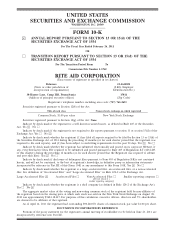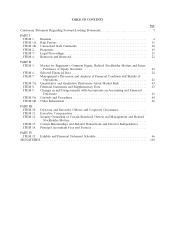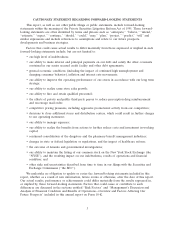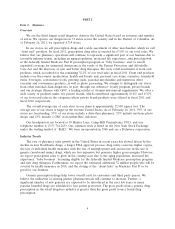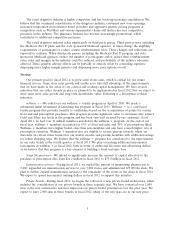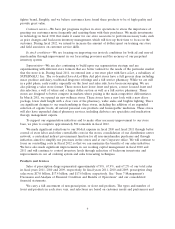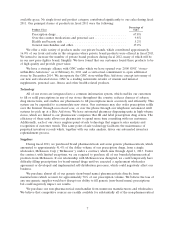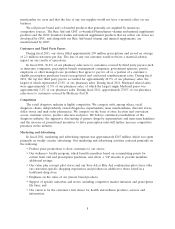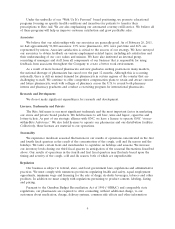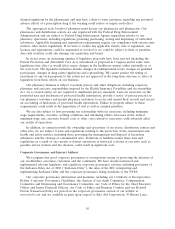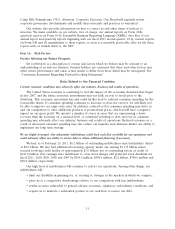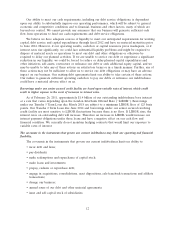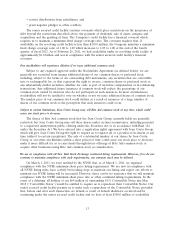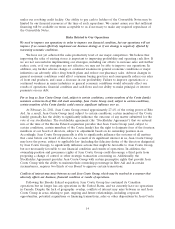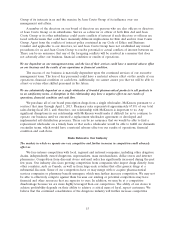Rite Aid 2011 Annual Report Download - page 5
Download and view the complete annual report
Please find page 5 of the 2011 Rite Aid annual report below. You can navigate through the pages in the report by either clicking on the pages listed below, or by using the keyword search tool below to find specific information within the annual report.The retail drugstore industry is highly competitive and has been experiencing consolidation. We
believe that the continued consolidation of the drugstore industry, continued new store openings,
increased competition from internet based providers and aggressive generic pricing programs at
competitors such as Wal-Mart and various supermarket chains will further increase competitive
pressures in the industry. The pharmacy business has become increasingly promotional, which
contributes to additional competitive pressures.
The retail drugstore industry relies significantly on third party payors. Third party payors, including
the Medicare Part D plans and the state sponsored Medicaid agencies, at times change the eligibility
requirements of participants or reduce certain reimbursement rates. These changes and reductions are
expected to continue. When third party payors, including the Medicare Part D program and state
sponsored Medicaid agencies, reduce the number of participants and/or reduce their reimbursement
rates, sales and margins in the industry could be reduced, and profitability of the industry adversely
affected. These possible adverse effects can be partially or entirely offset by controlling expenses,
dispensing more higher margin generics and dispensing more prescriptions overall.
Strategy
Our primary goal for fiscal 2012 is to grow same stores sales, which is critical for our future
financial success. Same store sales growth will enable us to take full advantage of the improvements
that we have made in the areas of cost control and working capital management. We have several
initiatives that are either already in place or planned to be implemented in fiscal 2012 that we expect to
drive same store sales growth and long term shareholder value. Following is a description of these
initiatives:
wellness —We rolled out our wellness loyalty program in April of 2010. We made a
substantial initial investment in launching this program in Fiscal 2011. Wellness is a card based
loyalty program that provides benefits to cardholders based on the accumulation of points for certain
front end and prescription purchases. This program provides significant value to customers who achieve
Gold and Silver tier levels in the program and has been very well received by our customers. As of
April 2011, we had over 36 million members enrolled in the wellness + program. At the end of our
fiscal year, wellness + members accounted for 67% of front end sales and 58% of prescriptions filled.
Wellness + members have higher basket sizes than non-members and also have a much higher rate of
prescription retention. Wellness + members also are eligible to receive plus-up rewards, which are
discounts on certain items featured in our weekly circular and provide members with additional savings
for return shopping trips. We believe that the wellness + program has contributed to the improvement
in our sales trends in the fourth quarter of fiscal 2011. We plan on making additional incremental
investments in wellness + in fiscal 2012, both in terms of additional discounts and advertising dollars,
as we believe that this program is a key element of building a loyal customer base.
Script file purchases—We intend to significantly increase the amount of capital allocated to the
purchase of prescription files from $24.2 million in fiscal 2011 to $75.0 million in fiscal 2012.
Immunization services—During fiscal 2011, we tripled the amount of immunizing pharmacists to
7,400, expanded our immunization services to over 3,000 stores and administered 675,000 flu shots. We
plan to further expand immunization services to the remainder of the stores in the chain in fiscal 2012.
We expect to spend incremental training dollars in fiscal 2012 to support this initiative.
Private brands—During fiscal 2011, we began the rollout of a new private brand architecture, which
includes the consolidation of our private brands in three separate tiers. We have converted over 1,000
skus to the new architecture and have improved our private brand penetration over the prior year. We
expect to have 2,900 skus in these brands in fiscal 2012. Many of the new skus are in our new price
5

